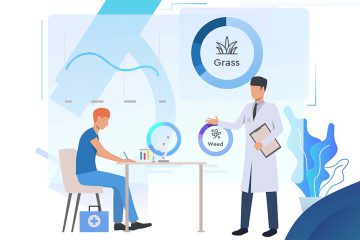Idea in brief:
- The United Nations estimates the global population to reach 9.8 billion by 2050, making the food and agriculture industry more important than ever
- To address the pressure of ever-increasing demands, stakeholders of the industry are seeking assistance from technology and data
- With accurate soil data, agricultural stakeholders can help the industry produce greater yields, curb operational inefficiencies, and find a smarter way to optimize farming
Agriculture is one of the broadest economic sectors in the world, and it plays a significant role in the overall socio-economic fabric of many developing countries. Agricultural practices do not end with farming; they are dependent on many factors such as soil, climate, irrigation, fertilizers, temperature, rainfall, among others.
Intricate complexities revolve around the sector. The essential issues lie in the accurate yield estimation, planning the location and area for growing, understanding the land fertility standards, and eventually growing the crops.

According to the United Nations’ estimation, the global population is bound to reach 9.8 billion by 2050, a 2.2 billion increase from the present. This means the world needs enough resources to feed all the people, making agriculture ever more important. However, today’s problems such as climate change, urbanization, and degradation of fertile land play a significant role in defining agricultural practices.
World hunger is another major issue that has been escalating every year. The Global Humanitarian Overview 2022 suggested that up to 811 million people are undernourished globally, compared to 235 million people in 2021 and 168 million in 2020. The report also states that food insecurity is at unprecedented levels. Food insecurity can worsen diet quality and increase the risk of various forms of malnutrition, potentially leading to the extremes of undernutrition or obesity.
To address the pressure of ever-increasing food and product demands, stakeholders of the industry are seeking assistance from technology forces such as IoT, big data, analytics, and cloud computing.
Data and Analytics to the Rescue
Countries across the globe have been collecting local data on their soil and have found strategies to optimize farming. In Austria, for example, conservation agriculture is a common practice where there is minimal disturbance to the land used for farming. This boosts the natural underground biological processes and leads to healthier soil. Countries like Ireland also depend on satellite-based soil and crop monitoring to inspect areas more quickly than traditional methods.
Data from such local experiments can play an essential role in the global quest for improving soil quality by providing critical insights into farming strategies in specific geographic and climatic contexts. However, what can significantly influence this sector is global and hyperlocal soil data. This data can help increase the overall efficiency of crop production while considering all the influencing factors.
The most crucial step is understanding the land, which can be done via data collection. Soil data can help determine the fertility of the land, how much recovery time it requires and the best approach towards moving forward with the recovery process. The data collected can be analyzed to understand the gravity of the situation and how to handle it.
Real-time sensors, satellite imagery, historical evidence, and hyperlocal data can help generate patterns to contribute to the analysis. Such technologies can help pinpoint existing issues, like inefficiencies in operations and poor soil quality, and formulate algorithms that can predict and alert even before a problem occurs. Data gathering and clustering techniques are necessary approaches to achieve practical and effective solutions for this problem.
Environmental conditions such as intense weather, variability in soil, and commodity prices have made it more relevant for industry stakeholders to use the information to make critical farming decisions using modern technologies. Utilizing existing crop, soil, and climate data and analyzing the real-time data optimizes the production and makes agriculture more resilient to climate change.
Using artificial intelligence and machine learning techniques, agricultural stakeholders can utilize soil data to:
- Monitor and manage farms effectively: Soil data can help improve the efficiency of water usage in agriculture and optimize it according to the crop requirements. In case of limited water resources, the farmers can detect and limit watering at only the critical phases of the crop cycle. The system helps avoid over irrigation, thus protecting crops and saving water.
- Curb operational inefficiencies: Accurate soil data can help speed up the farming process and attribute the exact amount of time needed to produce maximum yield. Real-time weather data can be integrated with it to move the yield to market. An accurate estimation of crop production and risk helps their supply chain division schedule their delivery. Based on those estimates, businesses such as seed, fertilizer, agrochemical, and machinery can also plan production and marketing activities.
- Locate fertile areas: With satellite imagery and geospatial data, it becomes easier to understand which land is perfect for what type of crops. Understanding the weather patterns and soil quality can also contribute to the process.
- Enhance agricultural processes with precision agriculture: Agricultural stakeholders can utilize the data collected from satellite imagery and remote sensing to assess the current state of their fields and manage nutrients in real-time. Geographical Information System (GIS) maps can also inform them about specific characteristics of the soil, such as where it is sufficiently moist and where it is not. These processes can help them enhance and optimize their practices according to their specific requirements.
- Understand crop rotation patterns: Understanding crop rotation practices to reutilize the barren land and grow crops that can replenish the soil can go a long way. Soil data can help analyze lands that can be revitalized using this process.
- Forecast risks: Historical data can help stakeholders understand the past crop yield record, analyze the risks, and mitigate similar potential threats they may face in the future.
- Feed the population: Environmental data provides farmers with rainfall patterns, fertilizer requirements, land fertility, and more. Smart decisions on what crops to plant, when to harvest, and how to gain better profit can be facilitated through the help of data. This ultimately helps generate greater yield while maximizing the profits to produce more food for the general population.
The Future of Farming
Soil type and quality differ from place to place. Fertile soil has been affected globally due to the rise in temperature, flooding, water scarcity, and more. A growing population needs more produce than ever before, while at the same time, the dynamic weather conditions do not help with consistency. When external factors start affecting the land, like when the soil gets dry and provides less produce than it used to, it’s time to change the plan.
With the introduction of data analytics and site-specific crop management routines, the land can be rejuvenated to produce quality yields. Soil and other environmental data can help the agriculture industry monitor their land fertility, find efficient ways to increase their yields, and build a healthier planet in the process. Get soil data at your fingertips.
Learn more about smart farming

A creative writer from the heart, a content writer by profession. I spend most of my time reading about something if I’m not outside discovering it. I’m a nature lover and an environmental enthusiast. I believe that every human has a social responsibility to protect the environment they live in, and we must all play our part, however small it may be.





